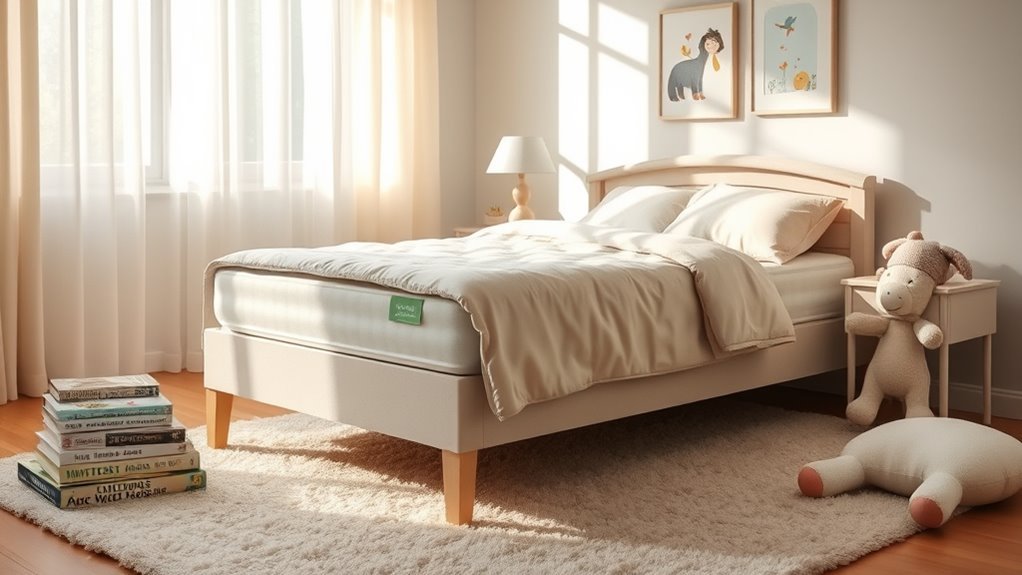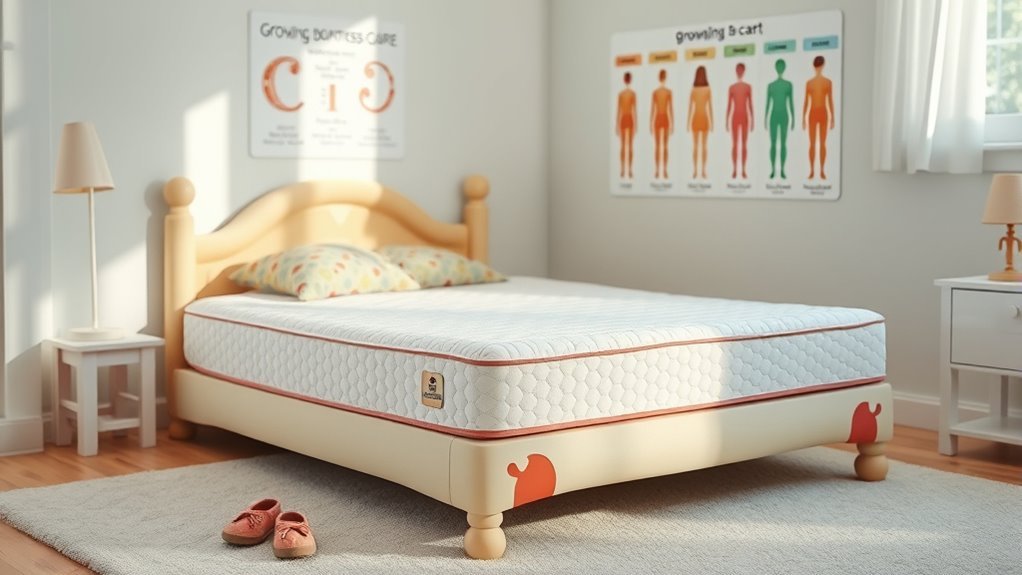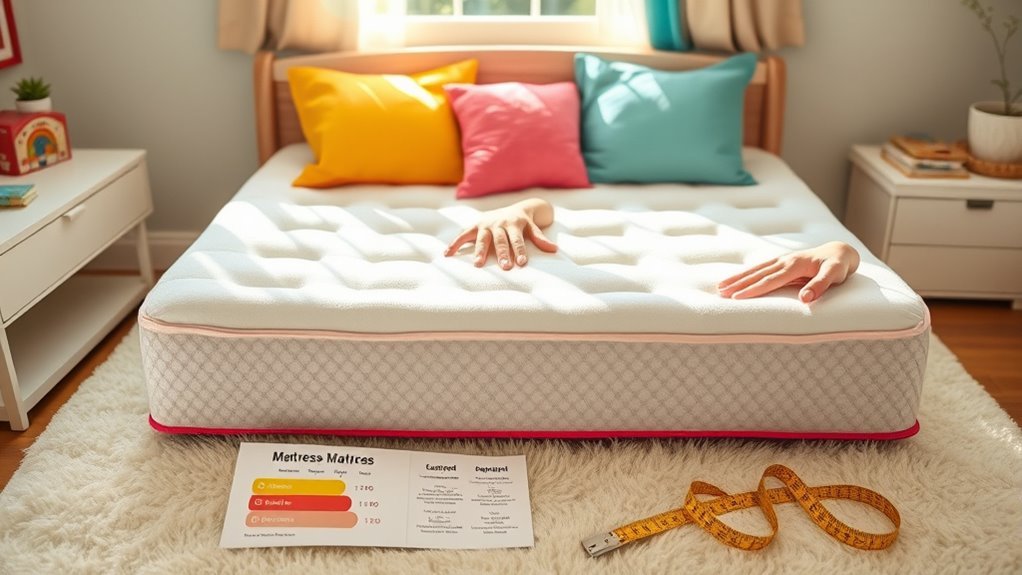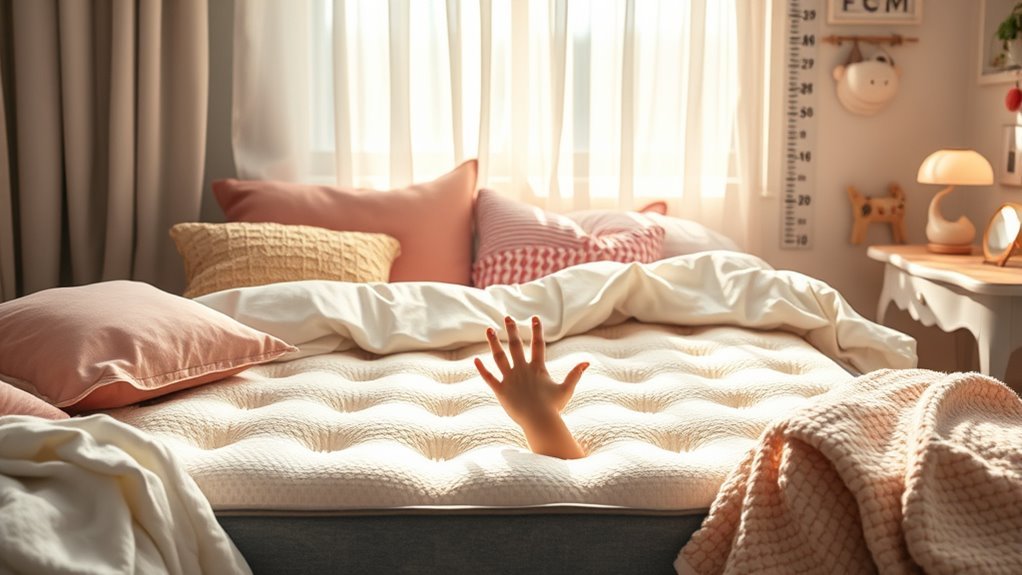When selecting a mattress for kids with growing pains, prioritize support and comfort. Look for one that maintains proper spinal alignment, such as a medium-firm bed. Memory foam or hybrid options can contour to their body while providing breathability. Don’t forget to check materials for safety and durability. Involve your child in testing firmness levels to find what feels right. With some careful consideration, you can create a restful sleep environment that promotes growth and reduces discomfort. More insights await you to guarantee the best choice.
Understanding Growing Pains and Their Impact on Sleep

As your child grows, you might notice that they occasionally complain of aches and pains, especially in their legs or joints—these are often referred to as growing pains. While typically harmless, growing pains can lead to sleep disturbances, making it hard for your child to settle down at night. When they’re uncomfortable, it’s more challenging for them to enjoy the restful sleep they need for healthy growth and development. You can help by encouraging gentle stretching or warm baths before bedtime. If the discomfort persists, don’t hesitate to consult a healthcare professional. Understanding these aches and their impact on sleep can empower you to create a comforting environment, allowing your child the freedom to rest easy and thrive.
Importance of Mattress Support for Growing Bodies

Growing pains can often leave kids restless at night, making the choice of mattress even more important. A supportive mattress helps maintain proper mattress alignment, which is essential for their growing bodies. When your child sleeps on a mattress that provides adequate spinal support, it can alleviate discomfort and encourage better sleep. The right support guarantees that their spine remains in a neutral position, reducing the risk of developing posture issues as they grow. Investing in a quality mattress not only enhances comfort but also promotes healthier sleep patterns. Remember, a well-supported body can lead to fewer sleep disturbances, allowing your child the freedom to rest and recover, ultimately making their days more enjoyable.
Mattress Types: Which One Is Best for Your Child?

How do you choose the right mattress type for your child? Start by considering their unique needs. Memory foam mattresses contour to their bodies, providing excellent support and pressure relief, which can be beneficial for kids experiencing growing pains. If your child prefers a bouncier feel, innerspring options offer that traditional support, promoting airflow and keeping them cool. Hybrid mattresses combine the best of both worlds, featuring layers of foam and coils for balanced comfort. Don’t overlook latex benefits, either; they’re naturally hypoallergenic and provide excellent durability. Each type has its strengths, so think about what’ll suit your child’s sleeping habits best. Your choice can make a significant difference in their comfort and overall well-being.
Firmness Levels: Finding the Right Balance
When it comes to selecting the right firmness level for your child’s mattress, it is vital to strike a balance between comfort and support. For younger children, a softer mattress firmness can provide the cozy feel they need while still offering adequate support for growing bodies. As they age, typically around 8 years old, firmer options are often recommended to accommodate their increasing weight and activity levels. This guarantees proper spinal alignment, reducing the risk of discomfort and growing pains. Remember, every child is unique, so it’s important to involve them in the decision-making process. Encourage them to test different firmness levels to find what feels best. A comfortable mattress can make all the difference in their sleep quality and overall well-being.
Materials Matter: Choosing Safe and Comfortable Options
While selecting a mattress for your child, it’s essential to take into account the materials used, as they can greatly influence both safety and comfort. Look for mattresses made with eco-friendly materials, which not only support your child’s health but also contribute to a healthier planet. Natural latex, organic cotton, and wool are excellent choices that provide breathability and durability. Additionally, consider hypoallergenic options to minimize the risk of allergies and irritations, ensuring a peaceful night’s sleep without discomfort. Remember, your child’s well-being is paramount, and investing in a quality mattress with safe materials can make a significant difference in their overall sleep quality. Prioritize their comfort so they can grow and thrive without the burden of growing pains.
Size Considerations for Growing Kids
Finding the right mattress materials is just the beginning; size plays a significant role in guaranteeing your child’s comfort and support as they grow. As your child experiences growth spurts, shifting from a twin size to a full size mattress might be necessary. This guarantees they have enough space to stretch out and move comfortably.
Here’s a quick guide to help you decide:
| Mattress Size | Ideal Age Range | Considerations |
|---|---|---|
| Twin Size | 3 – 7 years | Good for small rooms |
| Full Size | 8 – 12 years | Offers more space |
| Full Size | 13+ years | Supports teenage growth |
| Shifting | Varies | Time for a bigger bed |
Choosing the right size can make a world of difference in your child’s sleep quality.
Durability and Longevity: Investing in a Quality Mattress
Investing in a quality mattress is essential, especially since kids can be tough on their sleeping surfaces. You want a mattress that can withstand the wear and tear of growing bodies, so look for options made from quality materials. A durable mattress not only supports your child’s growth but also offers comfort, helping them sleep better. Don’t forget to check mattress warranties, as they can indicate the manufacturer’s confidence in their product’s longevity. A good warranty can give you peace of mind, knowing you’re covered if anything goes wrong. Ultimately, choosing a resilient mattress is an investment in your child’s well-being, allowing them the freedom to move, grow, and rest soundly through their developmental years.
Budgeting for Your Child’s Mattress Needs
When it comes to budgeting for your child’s mattress, it’s important to weigh affordable options without sacrificing quality. Consider how a good mattress can be a long-term investment, supporting your child’s growth and sleep needs for years to come. By balancing cost and durability, you can guarantee that your choice benefits both your wallet and your child’s well-being.
Assessing Affordable Options
Although choosing a mattress for your child can feel overwhelming, setting a budget can simplify the process. By exploring budget-friendly options, you can find a mattress that meets both your child’s needs and your financial limits. Keep an eye out for mattress sales, which can offer significant savings. Here are some tips to help you navigate affordable choices:
- Research different brands for quality and pricing.
- Consider online retailers for competitive deals.
- Look for eco-friendly materials that might be cost-effective.
- Check for warranties and return policies.
- Read customer reviews to gauge satisfaction.
Long-term Investment Value
Finding a budget-friendly mattress doesn’t just stop at the initial purchase; it’s also about evaluating the long-term investment value. A quality mattress can provide your child with the necessary support for years, enhancing their sleep and overall well-being. This investment can yield significant benefits regarding comfort and health.
Here’s a breakdown to evaluate:
| Mattress Type | Estimated Lifespan | Investment Benefits |
|---|---|---|
| Innerspring | 7-10 years | Good bounce and support |
| Memory Foam | 8-12 years | Pressure relief and durability |
| Hybrid | 10-15 years | Combines benefits of both |
Tips for Testing Mattresses Before Purchase
When you’re testing mattresses for your kid, it’s important to focus on comfort, support, and size. Make sure the mattress feels just right for your child and offers the right support for their growing body. Also, consider the space in their room to make sure it fits well without overwhelming the area.
Comfort Level Assessment
Before you make a purchase, it’s essential to assess the comfort level of a mattress to guarantee it meets your child’s needs. Comfort plays a key role in ensuring a restful sleep, especially for kids experiencing growing pains. Here are some practical tips for testing mattress firmness and suitability for their sleep posture:
- Lie down on the mattress in different positions (back, side, stomach)
- Assess how well it conforms to your child’s body shape
- Check for pressure points by feeling for any discomfort
- Consider how easily they can change positions during the night
- Test the mattress for bounce and support when sitting on the edge
Supportive Features Check
While evaluating a mattress for your child, checking its supportive features is essential to guarantee proper spinal alignment and overall comfort. Start by testing the mattress support—lie down and observe if it cradles the body while keeping the spine aligned. Pay attention to how the mattress responds to movement; a good mattress should provide stability without excessive sinkage. Encourage your child to try different positions to identify their comfort preferences; this will help you understand their specific needs. Don’t hesitate to ask questions about the materials used, as quality can greatly impact support. Finally, consider how the mattress feels under pressure, as this can affect long-term comfort and growth. Making a thoughtful choice now can alleviate future growing pains.
Size and Space Considerations
Choosing the right mattress size for your child is essential, as it directly impacts their comfort and sleep quality. When considering mattress dimensions, think about your child’s growth and the room layout. Here are some tips for testing mattresses before purchase:
- Test for Space: Verify the mattress fits comfortably in the designated area.
- Lie Down: Have your child lie down in their preferred sleep position to assess comfort.
- Check for Movement: Encourage them to roll around to see if the mattress provides adequate support.
- Consider Bed Frame Compatibility: Confirm the mattress works well with their bed frame.
- Height Consideration: Make certain your child can easily get in and out of bed.
Taking these steps will help you make an informed decision that fosters restful sleep.
Frequently Asked Questions
How Often Should I Replace My Child’s Mattress?
You should replace your child’s mattress every 5 to 7 years, as research shows that a mattress loses about 30% of its support and comfort over this period. Look out for signs of replacement like sagging, lumps, or your child complaining of discomfort. An uncomfortable mattress can hinder their sleep quality, so keeping an eye on its condition guarantees they get the restful sleep they need to grow and thrive.
Can a Mattress Affect My Child’s Growth?
Yes, a mattress can affect your child’s growth. If it’s too firm or too soft, it can disrupt sleep quality, leading to fatigue and impacting their overall development. A mattress that’s supportive yet comfortable helps guarantee your child gets restorative sleep, promoting healthy growth. Consider their needs and preferences to find the right balance in mattress firmness, so they can sleep soundly and wake up refreshed, ready to embrace the day.
Are There Specific Brands Recommended for Kids With Growing Pains?
When choosing a mattress for your child with growing pains, consider brands offering memory foam or hybrid options, as they provide excellent support and comfort. Look for well-reviewed models from companies like Nectar or Purple, which emphasize pressure relief. It’s important to guarantee the mattress suits your child’s preferences and needs. Don’t hesitate to test a few options together—finding the right fit can make a significant difference in their sleep quality and comfort.
What Age Is Best to Transition to an Adult Mattress?
You’ll want to shift your child to an adult mattress around ages 10 to 12. At this point, their growing body needs more support. Think of it like upgrading from a cozy blanket fort to a sturdy treehouse! An adult mattress can offer better firmness tailored to their size and shape, ensuring your child’s comfort. Just remember to choose one that balances support and softness, so they can sleep soundly through their growth spurts.
Should I Consider Adjustable Beds for My Child?
Yes, you should definitely consider adjustable beds for your child. They offer adjustable benefits that can enhance sleep quality by allowing your child to find their most comfortable position. This adaptability can be especially helpful if your child experiences discomfort or growing pains. Plus, having the ability to change angles can make reading or relaxing in bed more enjoyable. It’s a practical choice that gives your child the freedom to customize their sleep experience.



